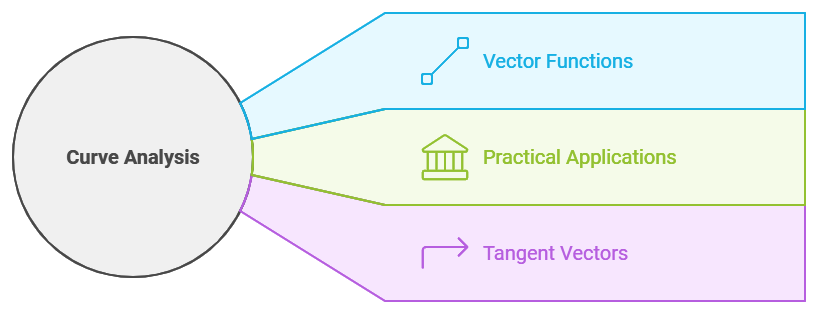Introduction
Understanding the properties of curves through vector functions is essential in advanced mathematics and physics. Vector functions offer a way to define curves in space by mapping out each coordinate, helping students visualize complex paths. This foundation supports further study into key concepts like the normal and osculating planes, which provide deeper insights into a curve’s behavior. By learning how to find the osculating plane and calculate the normal plane, students unlock the tools needed for accurate mathematical analysis.
These calculations play a pivotal role in real-world applications, especially in fields like engineering and physics, where understanding forces and trajectories is essential. Calculating the unit tangent, normal, and binormal vectors builds a comprehensive picture of curves, blending theoretical math with practical uses. As we explore vector functions and plane equations, we’ll dive into the details of how these concepts guide not just mathematical understanding but also real-life applications.
Key Takeaways
- Vector functions define curves in space, enabling a visual understanding of complex paths in mathematics.
- Calculating normal and osculating planes helps students analyze curve behaviors and changes in 3D space.
- Tangent, normal, and binormal vectors form a comprehensive framework for studying curves.
- The normal plane provides insights into forces acting perpendicularly along curves, crucial in engineering.
- Osculating planes offer precise understanding of curve trajectories, essential in physics and motion analysis.
- Understanding these concepts bridges theoretical math with real-world applications, enhancing practical problem-solving skills.
The Role of Vector Functions in Curve Analysis
Vector functions play a key role in studying curves, especially in advanced calculus and multivariable contexts. They define curves using parameters like r(t), where each coordinate—x(t), y(t), and z(t)—maps out the curve’s shape in space. This process allows students to visualize complex paths mathematically, bridging theoretical concepts with practical applications. Understanding these vector functions lays the foundation for deriving elements like the tangent vector and unit normal vector, which provide insights into the curve’s orientation. Whether learning about the unit tangent or moving to find the equation of the normal plane at the curve at the given point, this foundation is indispensable. Vector functions simplify how curves are represented, offering tools that students need to continue building more comprehensive learning in math and science.
Definition and Use of Vector Functions in Mathematics
Vector functions are foundational in mathematics, especially when analyzing the behavior of curves in 3D space. Defined by parameters, such as \( r(t) \), vector functions map out a path using coordinates that change with a variable, often time. By breaking down these functions into components like x(t), y(t), and z(t), students can visualize complex paths. This understanding is essential when deriving tangent and unit normal vectors, forming the basis for further applications, like calculating the osculating plane. As students study the role of vector functions, they not only gain insights into abstract curves but also learn about key concepts that enhance problem-solving in calculus and physics.
Understanding Tangent and Normal Vectors in Curve Study
The tangent and normal vectors are core components in curve analysis, helping to define a curve’s orientation and direction at specific points. By deriving the tangent vector from a vector function, students get a sense of the curve’s immediate path. Calculating the normal vector, perpendicular to this tangent, adds depth to this analysis, especially when dealing with the normal plane. Together, these vectors allow students to identify properties like curvature and behavior changes within the curve, creating a practical approach to complex calculations. Mastering these vectors is crucial for students looking to strengthen their knowledge in geometry, providing them with tools for accurate curve study.
Key Steps for Applying Vector Functions in Curve Analysis
1. Define the Purpose of Curve Analysis
Understanding why curve analysis is essential in fields like physics and engineering helps students grasp its real-world impact. Identifying practical applications can make studying vector functions more engaging and purpose-driven.
2. Break Down Vector Functions into Components
Decompose vector functions into their x(t), y(t), and z(t) components to clarify how each part contributes to defining the curve. This breakdown makes complex functions more manageable and easier to analyze.
3. Identify and Plot Key Points on the Curve
Select and plot critical points using the vector function to create a visual roadmap of the curve. Visualizing these points enhances comprehension and reveals the curve’s path and behavior.
4. Calculate Tangent and Normal Vectors for Orientation
Derive the tangent and normal vectors to understand the curve’s orientation at various points. These vectors provide directional information essential for further analysis, such as formulating the osculating plane.
5. Apply Curve Analysis to Practical Scenarios
Relate the results from vector functions and plane equations to real-life scenarios, such as modeling forces or designing structures. This application bridges academic study with practical utility, enriching the learning experience.
Understanding the Normal Plane Equation in Calculus
The normal plane is a concept vital for curve analysis, offering deeper insights by establishing a plane perpendicular to the curve’s tangent at a particular point. To find this expression, students start by identifying the point (P) on the curve, derived from the vector function, and use the unit normal vector for accuracy. Calculating the normal vector from the tangent line includes the dot product, providing an orthogonal view of the curve and adding dimensionality to its properties. This approach helps both students and professionals use mathematical planes to connect geometric principles with real-world phenomena. Mastering these equations enhances our understanding of the complex behaviors and detailed aspects of mathematical curves, guiding us in exploring their broader applications.
Steps to Derive the Normal Plane Using Vector Functions
The process of deriving the normal plane equation involves identifying the point \( P \) and the normal vector, both critical for accurate curve representation. The point \( P \), found through the vector function \( r(t) \), serves as the foundation, while the normal vector is calculated by taking the perpendicular of the tangent vector. By plugging in these elements, students can formulate an equation that represents the normal plane effectively. This approach helps illustrate the geometry behind complex shapes, giving students insights into real-world applications and providing a structured method for tackling similar problems in calculus.
Applications of the Normal Plane in Advanced Calculus
In advanced calculus, the normal plane is more than a theoretical tool; it’s a way to represent changes in direction and curvature along a curve. By deriving the normal plane, students can understand how curves behave in 3D space, providing context to problems involving spatial analysis. This concept is highly applicable in engineering, where understanding forces on structures is essential. Mastering the normal plane equation equips students to apply calculus principles to real-world situations, fostering both academic understanding and practical skills in spatial geometry and physics.
Case Study: Using Normal Planes in Bridge Design
In engineering, calculating the normal plane is essential when analyzing structural forces. A prime example can be seen in bridge design, where understanding the forces acting perpendicular to the bridge’s surface helps engineers determine where to reinforce structural support. When designing a suspension bridge, engineers use the normal plane to evaluate stress points along the bridge cables and deck. By calculating the normal vector, they pinpoint areas prone to stress, ensuring these spots are supported adequately to handle load variations.
This calculation has a significant impact on safety and durability. For instance, the Golden Gate Bridge’s designers applied these principles, reinforcing critical points along the cables and towers based on load projections. The process of finding and applying the normal plane not only informs structural design but also guides maintenance efforts, ensuring the bridge can withstand environmental changes and continuous use. This case study exemplifies the practical value of normal plane calculations in creating safe, resilient structures.
Exploring Osculating Plane Calculations and Their Significance
Osculating planes offer an insightful glimpse into how curves behave at precise points, combining both tangent and curvature elements. The key to finding the equation of the osculating plane lies in calculating the binormal vector, derived from the cross product of the unit tangent vector and normal vectors. Once the tangent vector is identified, students proceed with the unit tangent and unit binormal vectors to form a complete perspective on the curve’s direction and changes. This osculating plane of the curve not only encapsulates the curve’s path but also enriches the analysis with curvature information, which is essential in fields like multivariable calculus and physics. Such insights are indispensable for students aiming to grasp complex calculus principles and their applications in geometry.
The Role of the Tangent Vector in Osculating Plane Equations
The tangent vector is essential when calculating the osculating plane, as it represents the direction of the curve at any given point. To find this vector, students take the derivative of \( r(t) \), setting the stage for deeper analysis. The tangent vector not only indicates the curve’s immediate path but also interacts with the normal vector to form the binormal vector. These vectors together create the osculating plane, encapsulating both the curve’s direction and its curvature. This process is fundamental in calculus, helping students gain insights into the intricate behaviors of curves, enhancing their understanding of spatial dynamics.
Using the Binormal Vector for Comprehensive Curve Analysis
The binormal vector completes the set needed for an accurate osculating plane equation. Derived from the cross product of the tangent and normal vectors, the binormal vector provides the third dimension to the curve’s spatial analysis. This combination captures the curve’s curvature and direction, making it especially useful in fields like physics, where motion analysis requires detailed 3D understanding. By including the binormal vector, students gain a full perspective on the osculating plane, reinforcing their knowledge of how to apply vector functions to complex geometry and enhancing their problem-solving skills in multivariable calculus.
“Mathematics reveals its secrets only to those who approach it with pure love, for its own beauty.” — Archimedes
Practical Applications of Plane Equations in Mathematics and Physics
Plane equations like those for normal and osculating planes extend beyond theoretical exercises, serving as foundational tools in mathematics and science. These concepts are critical for applications in differential geometry, where the properties of curves are analyzed to model real-world behaviors. Engineers and physicists rely on these equations to map trajectories, assess structure stability, and even design mechanisms based on mathematical models. By mastering the use of unit tangent, normal, and binormal vectors, students gain skills directly transferable to solving practical problems. Understanding these applications provides students with a comprehensive perspective on how geometry intersects with real-world challenges, bridging the gap between academic learning and professional practice.
The Importance of Osculating Planes in Physical Applications
Osculating planes provide a detailed view of how objects move along curves, making them essential in physics. Engineers use osculating planes to understand trajectories and evaluate forces, especially in scenarios requiring high precision. From designing roller coasters to analyzing planetary motion, osculating planes allow professionals to model curves accurately, ensuring safety and functionality in real-world applications. This concept gives students a glimpse into the practical side of calculus, showing how mathematics underpins everyday technology and scientific exploration, bridging theoretical study with tangible results.
Real-World Applications of Normal Planes in Engineering
Normal planes are valuable in engineering, particularly for analyzing forces acting on structures. By identifying a plane perpendicular to the curve’s direction, engineers can better predict stress points and optimize designs. For example, in bridge construction, calculating the normal plane helps in identifying where to reinforce support. This knowledge shows students the broader uses of calculus, connecting mathematical equations to practical, impactful applications in engineering. Understanding how to derive and use normal planes provides students with a solid foundation for future careers in scientific fields, illustrating the relevance of mathematical theories.
Conclusion
Mastering vector functions and plane equations opens up a deeper understanding of curves, a crucial component in advanced mathematics. By calculating the normal and osculating planes, students gain insights into how curves behave and change in three-dimensional space, enriching their approach to complex calculus problems. These foundational tools not only clarify theoretical principles but also provide practical ways to model and analyze real-world phenomena.
From understanding trajectories in physics to optimizing structures in engineering, the ability to determine planes like the osculating plane has meaningful applications. Using unit tangent, normal, and binormal vectors, students can visualize curves and apply their skills to solve challenges across various fields. By connecting abstract math with practical uses, these concepts provide a solid foundation for students aiming to excel in areas where mathematics and science intersect, making complex ideas more accessible and applicable.


















